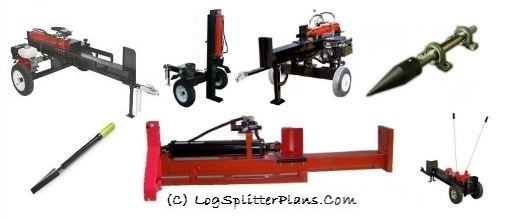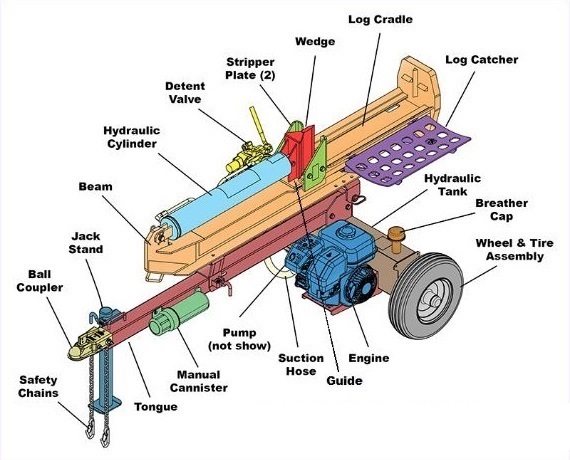Design Plans - Do It Yourself Home Built Log Splitter
Log Splitter Topics
Frequently Asked Questions
Our Log Splitter Topics Cover

- How does a log splitter work?
- The log splitter power source or engine drives a hydraulic
pump which is triggered through a hydraulic valve to pump hydraulic
fluid from a tank to extend inlet of the hydraulic cylinder.
This pushed the log into the splitting cycle. The cylinder has
two inlet sides and when the valve is moved the other way the
fluid is pumped into the alternate inlet to retract the hydraulic
cylinder. This moves the glide back to the starting position
to insert another log splitting.
- What are the advantages of using a log splitter?
- Log splitters can become
handy firewood production
tools that can save you time and money. When you have a
wood-burning stove or fireplace, the cost for a supply of split
wood can be greatly reduced if you can split your own supply
for those cold winter months.
- Do log splitters require any maintenance or service?
- Hydraulic gas engine powered log splitters do require
common inspection and
service requirements. Maintenance can include recommended
oil changes, hydraulic fluid filter replacement, inspections
for leaks, and component lubrication service.
- Do I need to sharpen the wood splitter’s splitting wedge?
- The splitting wedge should never need to be sharpening when
appropriately used. It should remain sharp as long as it is
being used on wood only and not abused.
- What type of hydraulic fluid is recommended for my log splitter?
- Check the Owners
Operation Manual and/or the NOTICE decal on the hydraulic
fluid tank for recommended fluid. This can be largely dependent
on the outside temperature where the log splitter is being used,
AW-68 is recommended for temperatures above 50°F.
- How often should the fluids be checked and changed?
- The fluids should be checked before every use.
- Engine oil should be changed annually, or based on active
use (see owners manual).
- The hydraulic fluid filter should be changed each year
- The hydraulic fluid if the system is kept clean can go for
longer. If oil is clear and looks like "new" it could work for
another season. Keep in mind that oxidation and moisture from
air along with how much "dirt and water" moves around could
trigger a more frequent need to change the hydraulic fluid.

- Our Log Splitter Buyers
Guide can help you sort through many questions related to purchasing
a log splitter. Common points of interest include:
- The type of log splitter i.e.
vertical,
horizontal,
3-point
etc.
- The power of a log splitter needed can vary but for a homeowner
splitting their own firewood, a 22-Ton or 27-Ton log splitter
is generally adequate. If you're producing large quantities
of firewood or splitting hardwood, a 28-Ton to 35-Ton log splitter
may be better. A firewood production business may bump that
to 40 or 50 ton.
- What are the physical difference between various
tonnage models?
- The size of the hydraulic cylinder is most significant difference,
and this can makes a difference in the time it takes to complete
a “cycle”, i.e., fully extend the rod, then retract to the start
position.
- The maximum log size length the splitter can accommodate.
Check your fireplace or wood stove for maximum width or depth
capacity before purchase. Generally logs are 24” to 30” in length.

- My log splitter hydraulic cylinder wont move when lever is triggered?
- Make sure the hydraulic tank fluid level is within one inch
from the top of the tank.
- The log splitter ram does not retract when the valve handle
is pulled for return, what is wrong? Check for burrs or wood
chips on the glide rail that may be preventing it from sliding back
into position, Lubricate.
- Who do I contact with questions on my splitter? Refer to the
Operator's Owner Manual
for assistance with your specific model.


